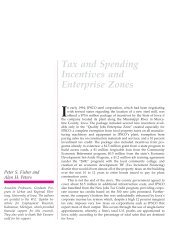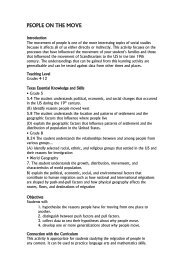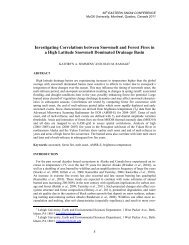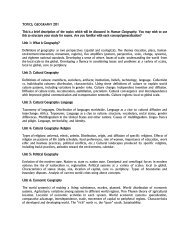Texas Social Studies Framework - Department of Geography ...
Texas Social Studies Framework - Department of Geography ...
Texas Social Studies Framework - Department of Geography ...
You also want an ePaper? Increase the reach of your titles
YUMPU automatically turns print PDFs into web optimized ePapers that Google loves.
52<br />
52<br />
• Debriefing: Allowing students to debrief both in<br />
writing and orally works well. This stage is key;<br />
it is the teacher’s chance to ask students to<br />
discuss, to reason, to draw conclusions, and to<br />
pull everything together.<br />
Simulations are expanded role-playing activities that<br />
recreate real-life situations or historic events according to<br />
a set <strong>of</strong> specified guidelines or rules. After the simulation<br />
problem or issue is carefully explained, the rules for the<br />
simulation are specified. Roles must be clear and the<br />
resources or constraints <strong>of</strong> the simulation outlined.<br />
Debriefing is important and should help students focus<br />
on the process or procedure rather than on “who won.”<br />
Discussion Formats<br />
Every social studies teacher includes discussion in his or<br />
her teaching repertoire. But too <strong>of</strong>ten, discussion degenerates<br />
into unreasoned debate, where opinions are more<br />
important than viewpoints based on thought and research.<br />
There are several discussion models that can<br />
make discussions effective teaching-learning tools. For<br />
example, following research on a topic, in the ESR<br />
(Educators for <strong>Social</strong> Responsibility) model, the class is<br />
divided into two groups. Both groups present their<br />
position on the topic. The first group asks questions <strong>of</strong><br />
the second group, then restates the other group’s position<br />
as accurately as possible. The groups present a list <strong>of</strong><br />
agreements between the two positions. Finally, each<br />
group presents the questions that each can explore to<br />
resolve their differences. In the Socratic Discussion<br />
Model, also known as “the seminar,” students dissect a<br />
text, problem, or event to better understand it. Students<br />
ask questions and probe each other’s answers from<br />
different perspectives. Students can be assigned roles to<br />
make them more productive in the seminar.<br />
Classroom Learning Centers<br />
A learning center complex is set up with a series <strong>of</strong><br />
modules that include specific objectives and activities that<br />
use appropriate visual aids (Kosmoski and Vockell, 1978).<br />
In small groups, students complete an activity in one<br />
station and then move to the next station in the rotation.<br />
Benefits <strong>of</strong> using learning centers in the classroom<br />
include:<br />
• Students are motivated by being continually<br />
engaged in a variety <strong>of</strong> activities.<br />
• Limited resources can be effectively utilized. For<br />
example, in a one-computer classroom, one <strong>of</strong><br />
Chapter 5: The Teaching-Learning System: Curriculum, Instruction, and Assessment<br />
the learning stations can center around computer<br />
work so that eventually each student will be able<br />
to use the computer.<br />
• Learning centers make efficient use <strong>of</strong> time<br />
(O’Sullivan, 1984).<br />
• Students work cooperatively toward a common<br />
goal, building a working community <strong>of</strong> learners.<br />
In learning centers in grades K-3 students use<br />
manipulatives, clay and cookie cutters, blocks, art<br />
supplies, writing materials, reading matter, and listening<br />
devices (Timmons and Rogers, 1996). For example, in<br />
kindergarten, children can participate in stations that<br />
feature community businesses and services such as a<br />
bakery, hospital, post <strong>of</strong>fice, grocery store, fire station,<br />
police station and dentist’s <strong>of</strong>fice (see TEKS K.7.A;<br />
K.15.A, B; K.16.A, B).<br />
Learning centers in grades 4-8 feature manipulatives such<br />
as artifacts as well as technology for using interactive<br />
CD-ROMs and for constructing tables and graphs. Tools<br />
and supplies for cooking, making maps and crafts, and<br />
for building small structures are <strong>of</strong>ten included. Research<br />
materials are also available. For example, in Grade 6,<br />
students can investigate a particular country’s culture<br />
through learning centers. At one station, students listen to<br />
music <strong>of</strong> a country, sing, and dance. Other stations<br />
include watching a video, making a craft <strong>of</strong> the country,<br />
analyzing photographs <strong>of</strong> people and architecture,<br />
constructing a map, reading poetry and writing poetry in<br />
a similar style, wearing traditional clothing, cooking,<br />
exploring an interactive CD-ROM, and finding information<br />
about the country’s religious holidays on the Internet<br />
(see TEKS 6.18.A, B, D; 6.19.B; 6.21.A, E, C, D).<br />
In grades 9-12 students continue to make maps, manipulate<br />
artifacts, use supplies for art and construction, and<br />
use technology to create graphs, charts, and tables as<br />
well as for research and presentation. Some stations will<br />
include primary and secondary documents as well as<br />
atlases and other investigative tools. For example, in U.S.<br />
Government students can participate in a learning center<br />
format that emphasizes points <strong>of</strong> view on governmental<br />
issues though American history. At various stations,<br />
students do the following:<br />
• create a Venn diagram to compare and contrast<br />
the views <strong>of</strong> the Federalists and Anti-federalists;<br />
• create a data retrieval chart to trace the development<br />
<strong>of</strong> political parties from 1787 to the present<br />
identifying founders <strong>of</strong> the parties, governmental<br />
points <strong>of</strong> view, significant platforms, and<br />
contributions;
















